

Nnlm. Rfp. RFP. Literacy. Medication_safety. ATA. Food_desert. Information_literacy. Easy_to_read. Mchc. Physicians_assistants. Rss. How to Write a Great Blog Post in Just 15 Minutes. Have you ever wished you could write a great blog post in less than 15 minutes?
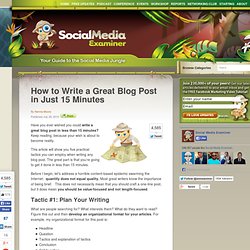
Keep reading, because your wish is about to become reality. This article will show you five practical tactics you can employ when writing any blog post. The great part is that you’re going to get it done in less than 15 minutes. Before I begin, let’s address a horrible content-based epidemic swarming the Internet: quantity does not equal quality. Most great writers know the importance of being brief. Tactic #1: Plan Your Writing What are people searching for? HeadlineQuestionTactics and explanation of tacticsConclusionCall to action Tactic #2: Create a Headline Bank Why do you think most blog posts fail? A headline bank is nothing more than a list of grabbers that will not only save you a huge amount of time in the initial writing process, but they attract your readers to the content. Questions When you begin by asking your readers a question, they feel as if you are speaking directly to them. Quotes. USA time zones map with current local time 12 hour format.
MedlinePlus Connect. November 10, 2010 [posted] In November 2010, NLM® introduced MedlinePlus Connect, a free service that allows any electronic health record (EHR) system to link to relevant, authoritative and up-to-date health information from MedlinePlus.
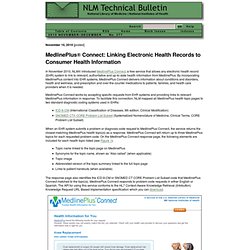
By incorporating MedlinePlus content into EHR systems, MedlinePlus Connect delivers information about conditions and disorders, health and wellness, and prescription and over-the-counter medications to patients, families, and health care providers when it is needed. MedlinePlus Connect works by accepting specific requests from EHR systems and providing links to relevant MedlinePlus information in response. To facilitate this connection, NLM mapped all MedlinePlus health topic pages to two standard diagnostic coding systems used in EHRs: Kansas School Nurse Organization. iPad's here, now what? News April 2, 2010 07:03 AM ET Computerworld - The iPad is nearly here.
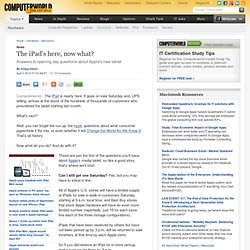
It goes on sale Saturday and, UPS willing, arrives at the doors of the hundreds of thousands of customers who preordered the tablet starting last month. What's next? Well, you can forget the run-up, the hype, questions about what consumer pigeonhole it fits into, or even whether it will Change the World As We Know It. Now what do you do? Those are just the first of the questions you'll have about Apple's media tablet, so like a good story, that's where we'll start. Can I still get one Saturday? All of Apple's U.S. stores will have a limited supply of iPads for sale to walk-in customers Saturday starting at 9 a.m. local time, and Best Buy stores that stock Apple hardware will have an even more limited number (reportedly, just 15 for each store, five each of the three storage configurations).
So if you did reserve an iPad for in-store pickup, make sure you're there by 3 p.m. What's in the box? MCH Library Knowledge Path: Early and Periodic Screening, Diagnostic, and Treatment (EPSDT) Services in Medicaid. Introduction This knowledge path about Early and Periodic Screening, Diagnostic, and Treatment (EPSDT) services in Medicaid has been compiled by the MCH Library at Georgetown University.
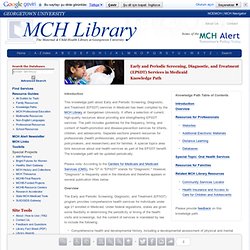
It offers a selection of current, high-quality resources about providing and strengthening EPSDT services. The path includes guidelines for the frequency, timing, and content of health-promotion and disease-prevention services for infants, children, and adolescents. Separate sections present resources for professionals (health professionals, program administrators, policymakers, and researchers) and for families. A special topics area lists resources about oral health services as part of the EPSDT benefit.
NCBI-NLM YouTube Channel. Public Health Management of Disasters: The Pocket Guide. Anxiety disorders in older adults- NIHSeniorHealth. For Immediate Release Wednesday, December 8, 2010 Anxiety caused by stressful events like moving or losing a job is a normal part of life.
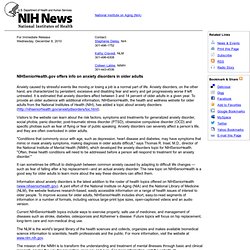
Anxiety disorders, on the other hand, are characterized by persistent, excessive and disabling fear and worry and get progressively worse if left untreated. It is estimated that anxiety disorders affect between 3 and 14 percent of older adults in a given year. To provide an older audience with additional information, NIHSeniorHealth, the health and wellness website for older adults from the National Institutes of Health (NIH), has added a topic about anxiety disorders ( Visitors to the website can learn about the risk factors, symptoms and treatments for generalized anxiety disorder, social phobia, panic disorder, post-traumatic stress disorder (PTSD), obsessive compulsive disorder (OCD) and specific phobias such as fear of flying or fear of public speaking.
Free Medical Journals. NIDDK Image Library. About.com Health Study Finds Online Health Advertising Increasingly Helpful. Health Literacy Presentations. Program members have created a collection of presentations on health literacy for interested individuals.

All are welcome to use the presentation slides, but we ask you to credit the noted study authors and presentation creators when necessary. Updated Systematic Review on Literacy and Health Outcomes This presentation provides a snapshot of the 2003 National Assessment of Adult Literacy (NAAL) data, followed by the findings from a 2011 systematic review of the evidence on the impact of literacy on health outcomes as well as the efficacy of interventions designed to mitigate the impact. By Stacey Sheridan Last Updated: 7.10.12 View PowerPoint. North Carolina Program on Health Literacy. Information Resources: Health Literacy: A Key Ingredient for Managing Personal Health. Barbara F.

Schloman, PhD, AHIP Citation: Schloman, B. (February 2004). Information Resources Column: "Health Literacy: A Key Ingredient for Managing Personal Health. " Safe Medication Practices. Health Care Quality and Safety. Library Statistics Program. National Assessment of Adult Literacy (NAAL) - Health Literacy 2003. The 2003 National Assessment of Adult Literacy (NAAL) is the first large-scale national assessment in the United States to contain a component designed specifically to measure health literacy—the ability to use literacy skills to read and understand written health-related information encountered in everyday life.
The NAAL health literacy component will establish a baseline against which to measure progress in health literacy in future assessments. The NAAL health literacy report—The Health Literacy of America’s Adults: Results From the 2003 National Assessment of Adult Literacy—provides first-hand information on the status of the health literacy of American adults age 16 and older. Results are reported in terms of the four literacy performance levels—Below Basic, Basic, Intermediate, and Proficient—with examples of the types of health literacy tasks that adults at each level may be able to perform. Key Features. Health Literacy - Ninth Annual Health Literacy Conference. Make your plans now to join us at the Institute for Healthcare Advancement’s 13th Annual Health Literacy Conference May 7-9, 2014 • Hotel Irvine-Jamboree Center Irvine, California Register Here IHA has organized a hands-on, continuing education conference every year since 2002.

The conference is called Operational Solutions to Low Health Literacy. Clear Communication: What is Health Literacy? What is health literacy?

Health literacy is: “The degree to which individuals have the capacity to obtain, process and understand basic health information and services needed to make appropriate health decisions.” — Source: Healthy People 2010. Making Health Communication Programs Work. Preface The National Cancer Institute will no longer print hard copy books or compact discs of Making Health Communication Programs Work , also known as the Pink Book. Full-length HTML and PDF versions of this publication can be printed via the Page Option tools on this page. (04/02/2008) This book is a revision of the original Making Health Communication Programs Work , first printed in 1989, which the Office of Cancer Communications (OCC, now the Office of Communications) of the National Cancer Institute (NCI) developed to guide communication program planning.
During the 25 years that NCI has been involved in health communication, ongoing evaluation of our communication programs has affirmed the value of using specific communication strategies to promote health and prevent disease. Research and practice continue to expand our understanding of the principles, theories, and techniques that provide a sound foundation for successful health communication programs.
Health Literacy: A Prescription to End Confusion. Report.

NHLBI Diseases and Conditions Explained in Plain Language. Medical Library Association: Health Information Literacy. The popular media and professional journals alike are increasingly carrying reports and studies of the difficulties and frustrations health professionals and patients face in coping with the barrage of available information in a way that results in informed health care decisions. There is a huge need to bring sense to the information universe if MLA's vision of "quality information for improved health" is to be achieved.
There is at the same time a significant gap in the awareness by the public and by opinion-leaders and decision-makers of the contributions that health sciences librarians can make (and are making) to bring order to the chaos. Literacy Improvement. Overview.